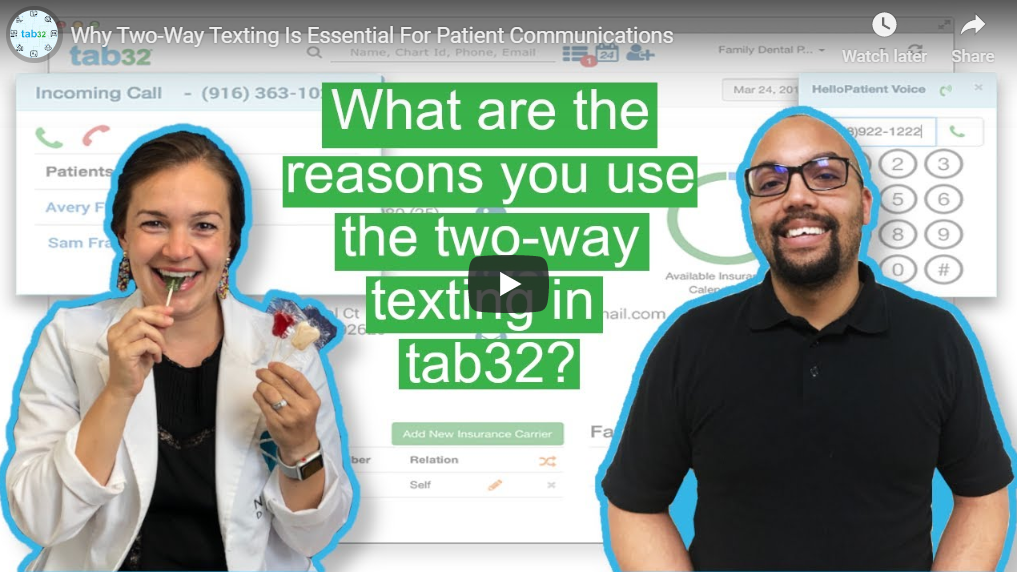Maintaining consistent patient communication is a key component in improving patient care and patient satisfaction.
However, most people are overwhelmed by email and many don’t like to answer the phone, which is often considered an invasive and outdated communication method by the younger generation. In fact, 90% of cell phone users don’t pick up incoming phone calls and many ignore voicemail messages -- 19% of people never check their phone messages!
While patient portals provide robust features for patients to manage their accounts and get notifications, having to log in every time to check a message is cumbersome and the inconvenience deters many from adopting it as a communication channel.
So how can you capture patients’ attention and make sure they’re receiving important communications from your dental practice?
Turns out, the solution is right under our nose!
The most common and preferred channel for patient communication is texting (SMS):
- 72% of Americans own a smartphone and 97% of them use their smartphones to text.
- 76% of patients consider texting more convenient than phone calls.
- 98% of text messages are read -- 5 times more than emails.
- 75% of patients prefer getting appointment and payment reminders, patient surveys, and other communications via text.
- 90% of texts are read within 3 seconds.
- Patients can respond to your text at their convenience and do it within just a few seconds. If they miss a call, they have to take minutes to check their voicemail and then call you back. The friction can reduce response rate and lower patient engagement.
- Since patients can communicate with you via text without having to install any additional app or software, there’s no friction in the patient experience.
Bottom line: people don’t check emails or take calls but they’ll respond to text messages!
In addition, texting not only allows you to reach patients more effectively but it’s also better for your business:
- Texting your patients takes a lot less time than sending an email. In fact, sending a text takes just 4 seconds while making a phone call takes 2 minutes.
- When you factor in labor, a phone call costs as much as $20 while a text costs you just pennies.
- You’re most likely to get a response via text: the average response time to a text is just 90 seconds, compared to 90 minutes for emails.
- Patients can make appointments through texting, which helps reduce the workload of your front-office staff.
- You can send links to online eForms for patients to complete paperwork ahead of time so you can reduce wait time and improve the patient experience.
- You can easily follow up with missing paperwork, insurance information, pre-treatment check-in, post-treatment care, and more to improve the patient experience while increasing operational efficiency.
- Eliminate phone tags, which are highly time-consuming and inefficient. Not only do they take up a lot of your staff’s time but they also increase friction in the appointment booking process, which can cause patients to switch to another practice.
- Text messages allow you to keep a record of the patient communications and you can import the information directly into their charts by integrating the patient communication system with your dental EHR platform for more effective patient care.
- Texting reduces the time your staff spend on managing patient communications so they can focus on other tasks and increase productivity without compromising the patient experience.
How To Use Text Messages To Augment Patient Experience
Here are some tips to help you take advantage of text messaging so you can optimize patient communications and improve patient experience:
- Use two-way texting through a web messaging platform that can handle both inbound and outbound SMS.
- Choose a patient communication software that is part of, or integrates with, your dental management practice platform so you can easily sych the communications into your dental EHR system without requiring your staff to spend time on manually transferring the information.
- Leverage automation to send appointment reminders, follow-ups on missed appointments, patient recall messages, incomplete treatment reminders, birthday messages, patient feedback requests, and more to help you build relationships, increase patient retention, reduce no-shows, and improve patient outcomes.
- Use a solution that syncs up with your patient contact record (or CRM system) so patients’ names will show up on incoming text messages. This allows your staff to look up the patients’ histories and address them by name to provide relevant information and a personalized experience.
- Ensure that the system is secure and HIPAA compliant to protect patient information while making sure that you don’t violate any regulatory standards and incur a hefty fine.
Two-way texting is a highly effective patient communication tool that allows you to automate experiential workflows for reminders, online patient intake, re-care reminders, patient surveys, and online scheduling.
It reduces friction in patient care, making it easy and convenient for patients to communicate with your practice -- allowing you to improve patient satisfaction and patient experience without putting extra workload on your staff.
To get the most of this popular communication method, choose a patient communication application that’s part of a dental practice management platform so you can integrate all the information into your patient records in real-time to enhance the quality of care you deliver.


No Comments Yet
Let us know what you think